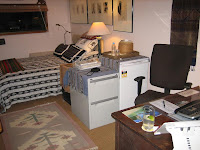This is the second in a series of articles about my first job in publishing – in the editorial offices of Time Magazine at Rockefeller Center, New York City. It was 1965 and I had just moved to New York. The first article in this series was My time at Time: Getting a job as proofreader.
The editorial week at Time began, officially, on Tuesday and ended on Saturday. However, many of the employees on the 24th and 25th floors – the editorial floors – worked a four-day week (Wednesday to Saturday). Even so, we all managed to accumulate a lot of overtime. Even staff such as layout artists, who worked only three days (Thursday to Saturday), often worked many hours of overtime, and this was very generously paid. In fact, Time's generosity to its employees at that time was legendary.
Catering events on both of the 'late' nights (Friday and Saturday) were an institution. Friday nights featured a 'cocktail hour', with a bar set up in the large 25th-floor 'lounge' equipped for just such events. And on Saturday night, when most of the editorial staff were expected to work as long as it took to 'close' the magazine, the company laid on a three-course meal, complete with silver service and white-coated chefs. Staff lined up with meal trays, selected from two or three main courses, and then took the dome-covered meal down to their desk to be consumed as work permitted. Later they would return for second helpings, and then a range of desserts plus assorted cheeses. I think there were little bottles of wine too, but maybe I'm wrong. Leftover pieces of cutlery and china were among the detritus to be cleared away at the beginning of the following week, as anyone scheduled to work extra late would have stashed away plates of cheese and biscuits and other titbits to see them through the night. At that time, there were very few fast-food outlets near Rockefeller Center that were considered safe destinations after midnight. Apart from this company-supplied food, the only other options were a few nearby restaurants that would deliver orders of Chinese and Italian meals. I suppose some of us also brought in food from home, but I don't recall that many people did.
The company also provided taxi-fares to everyone who worked after a certain hour (I think it was 8 or 9pm). This could be claimed the next week as petty cash. And except for Saturday night, when dinner was provided, late-working staff were also entitled to claim set amounts for one or more meals, according to the amount of hours they had worked on any day. No receipts were required for any of these claims, just the record of hours worked. So each week's petty cash entitlements were usually sufficient to pay for the following week's commuting fees. Working even later – after midnight, I think – entitled you to a door-to-door limousine service to your home, even when 'home' was somewhere an hour or more distant. I remember often opting for the taxi money instead of the limousine, and then taking my usual subway home. You could do very well out of petty cash that way.
The final largesse was a very generous profit-sharing system – more or less equivalent to a superannuation scheme, except that employees contributed nothing and were entitled to withdraw the proceeds on resignation, no matter how old (or young) they were. A certain copyboy, a member of the fledgling magazine's original staff, was said to have retired on what, in today's terms, was the equivalent of millions of dollars. (Unfortunately, he died not long after retirement.) At our resignation, my husband's and my profit-sharing proceeds were sufficient to pay our fares to Australia and set us up a flat in Sydney – not a bad return for a couple in their late 20s. Time's concentrated work week resulted from the desire to publish news that was as current as possible at the time of going to press. Theoretically the magazine 'closed' early on Saturday evening. Exactly what this mythical Saturday deadline was varied from time to time as the managing editor attempted to implement budgetary cutbacks. Each edition's cover-story, special colour features and some 'back of the book' sections (Art, Books, Film etc.) had earlier closing times, as these sections did not usually depend on late-breaking news. This meant that pre-press activities and even some printing could begin before later news sections of the magazine had closed. (Remember: I'm describing production activities of more than 40 years ago, before typesetting and other publishing tasks were computerised.)
No matter what the official closing time was supposed to be, it was rarely achieved. The final 'closing' for the week meant the last corrections to the last story were sent from the New York office to the printing plant in Chicago. Time rented direct telephone lines for the transmission of typeset stories as data. This was achieved by inserting rolls of perforated paper tape, whose perforations contained code for all text, punctuation and line-breaks, into machines in New York. This data was then transmitted electronically over those phone lines to the Chicago plant. Exactly how the lines of text were to be placed on each page was shown on full-size layout sheets on which graphic artists pasted up galley-proofs of text and 'bromides', or reproductions, of photos in actual final sizes to exactly fill each column of each page. These layouts, along with 150 or so possible photos that might be used that week, were dispatched to the Chicago printing plant in a series of packages sent via commercial flights on successive days of the editorial week.
In a later position at Time it was my job to arrange those packages and flights, no mean feat when Chicago had some of the worst winter weather and highest snowfalls of all the major US airports. For winter days when O’Hare Airport closed down completely due to bad weather, I had access to a group of daredevil messengers whom we would employ to hand-deliver Time’s well-identified large red cardboard envelopes to the Chicago printing plant. The messengers would choose from various alternative routes, including charter flights to smaller airports in towns near Chicago where shorter runways could be ploughed clear of snow just prior to landing a small plane. Or I would send fearless teams of messengers by overnight train, with instructions to go as far as possible by rail and then hire a truck or car for the rest of the journey. Sometimes, messengers set out in their own all-weather vehicles, choosing to make the 700-mile trip by road, and usually getting there. Even in good weather, unaccompanied packages sent via the regular weekly flights would sometimes go astray, turning up days, even weeks, later. Once a phone call from a Pacific island alerted me to the fact one of my red Time packages had been sitting at the airport there for weeks!
Original photos were always copied before being dispatched – sometimes from negatives, if we had them, but in the case of photos that had come in from wire services such as AAP, our lab would make a copy from the original photo before dispatching the original in one of the packages to Chicago. These back-up copies made from photos and not negatives were of reduced quality, and no one liked having to use them. But when packages containing original photos were lost or couldn't get through, and the photo was considered important, we might have no choice. If it was late in the week and there wasn't time to dispatch a replacement package, we might even have to resort to wiring this copy to Chicago via what was then a crude form of faxing. In such cases, difficult questions would be asked at the next week's post-mortem meetings. But I'll describe that process in a later article.
I remember one time when the mythical Saturday closing deadline actually was achieved. There was quite a celebration but in fact the success was probably the result of a boring news week. In any case, too early a closing would have wreaked havoc with the weekly poker game – another Time tradition – which moved from office to office, according to who was rostered as ‘late editor’ that week. Generally, however, no-one below the status of senior editor seemed to take the deadline very seriously. Last-minute news stories and additional facts and photos to go into existing stories were being added all the time. But eventually the week’s 'late man' – one of the production staff – would paste down the last line of type on the last page of layout and call the edition ‘closed’. This meant the last proofreading team, the last blue-pencil wielding writer and editor and the last copyboy could finally go home. Rarely did this happen before midnight. More often it was 2, 3, 5 or even 10am Sunday morning.
I remember occasionally working right through Saturday and Sunday and on to Monday morning – for example, on the weekend Robert Kennedy was assassinated, and again when Martin Luther King was shot. Events such as these resulted in all-new cover stories replacing whatever had been scheduled, no matter how late. On such occasions, the company would take a group of rooms in a nearby hotel and staff would go there in shifts to get some sleep (always on full pay, of course). Nor was it unusual to see a layout artist laid out on his work bench, sound asleep, his head on a stack of layouts. I remember at such times a certain prematurely bald, dapper little man who usually wore a crisp white shirt was the messenger who would sweep out of the elevator from the managing editor's office upstairs and sail down the hall into the complex of rooms on Floor 24 where production staff worked, calling out: 'Hold everything. New cover.' There would be groans and expletives all around, especially from persons who'd been foolish enough to make a date for midnight on what had seemed a quiet news week. I suspect the couches in editors' offices at Time saw more use – by sleepers, at least – than furniture in a lot of New York office suites.
I think an early proof of the magazine was delivered from Chicago to the managing editor's Connecticut home on Sunday. In any case, the first magazines were on New York newsstands on Monday morning and a copy on everyone’s desk in the Time offices on Tuesday. If that week's edition contained errors or faults of any kind, the storm would have had time to brew before production staff arrived at work on Wednesday, the beginning of our work week. Then the mood of gloom would be palpable even before you arrived at your desk. But if everything had gone well, those of us who began work on Wednesday would begin the job of cleaning up last week's mess. Long, lazy lunches were also a feature of these quiet Wednesdays – often paid for by the petty cash one collected from the downstairs business office on presentation of the previous week's timesheet.
In the next two articles in this series, I'll describe how proofreading was done at Time Magazine. I doubt any magazine today could afford to have as comprehensive (and expensive) a proofreading system as did the publications produced by Time-Life in those days.










